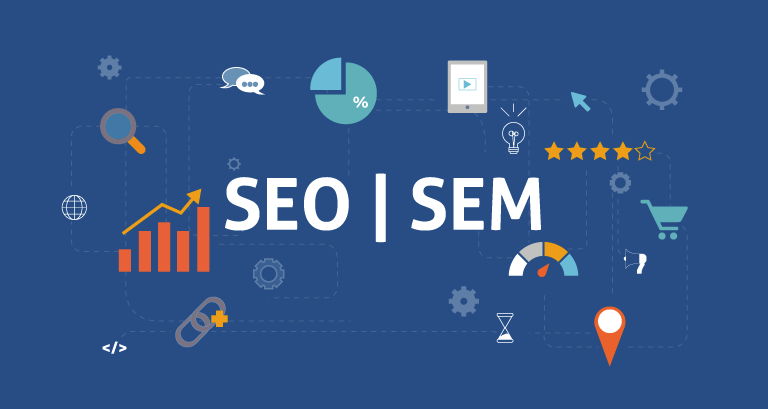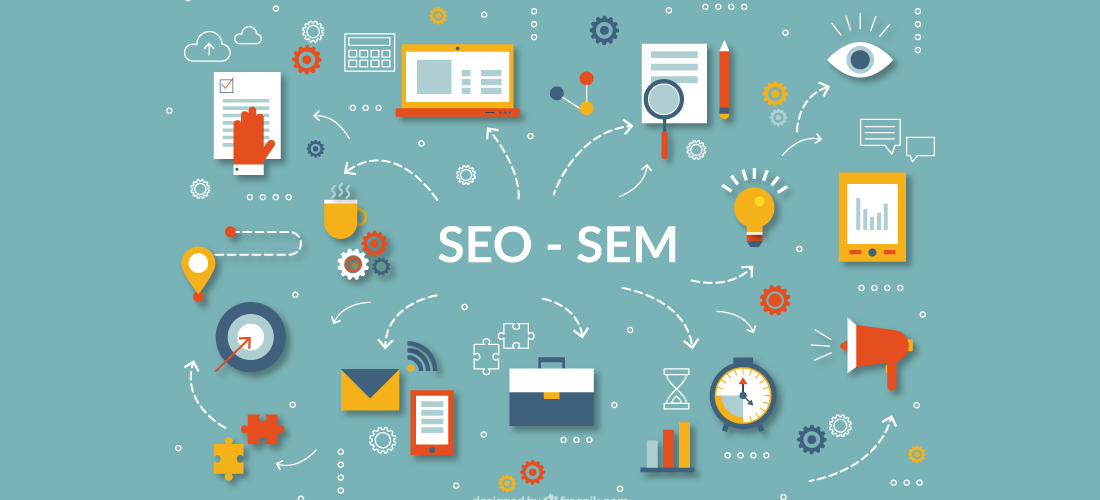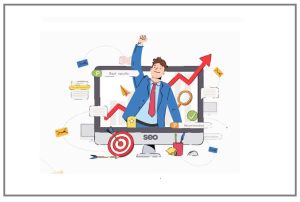Difference Between SEO And SEM

Today business is just a race. A race where search engines are a way to run with running websites. To grow your business or talk about winning a competition, you have to be very high. Search engines such as Google have two types of search results: paid results and natural results.
Paid results are when companies pay for clicks on Google.
Natural results are those displayed by Google in the SERPs that appear to be most relevant to the query.
To increase visibility in the SERPs. Business can use SEO or SEM
Difference Between SEO And SEM

To put it simply, SEO is a free strategy while SEM is a paid strategy. SEO integrates the process of optimizing your website and increasing live traffic. On the other hand, SEM refers to paid strategies such as Pay-per-Click (PPC) and SEO to bring paid and organic traffic to your website. Although the definition of SEM is always controversial among the public.
Some sources specify that SEO is a combination of paid and Organic results which is true as there are many SEO companies who charged there client for SEO work done on there online site while others believe that SEM is a paid method. But over time, the idea has changed dramatically and now SEM is considered a paid method, and all organic efforts fall only under the umbrella of SEO.
Let us consider both methods in detail.
SEO
Search engine optimization is a practice of improving your website to boost its ranking in the search results.
Read More : Seo Company Vancouver
There are several factors that determine which page you should measure which question you are asking and where. But in all these things, there are three great things.
1: On-page SEO
On-Page Search engine optimization is a way to optimize your website for search engines.
SEO features on the Page include:
- Title tags
- Meta Description
- Short and descriptive URLs
- SEO writing
- Image performance with alt tags
- Keyword placement and human consumption
- User engagement with advanced design
2: OFF-Page SEO:
Off-Page SEO is anything you do outside of your website to improve quality.
Examples of Off-Page SEO strategies are:
- Backlinks to your website
- I put on google my business
- Creating quotes
- Social features of your product
- Good review
3: Technical SEO:
Technical SEO means improving all the technical aspects of a website to improve the quality of organic search results.
Factors to keep in mind about technical SEO are:
- Improved page speed
- Crawling on search engines
- Canonical tags of duplicate content are used
- Hreflang tags for multilingual content
- Includes XML site map
What is SEM?
Search Engine Marketing (SEM) is a process of getting traffic through paid strategies to improve visibility and traffic. It relies heavily on PPC (you pay per click).
SEM refers to the use of PPC platforms such as Google ads and Bing ads. Google Ads are the most popular platform these days.
Whatever platform you choose to choose there are some things to keep in mind about effective SEM:
- Identify specific audiences for your ad campaign.
- Write a prepared ad copy
- Set Ad budget accordingly
- Analyze and monitor metrics such as clicks, CTRs, and costs per click
- Create social media ads
There are many other things that affect your ad campaign, but these five things are the most basic and most important. With keyword research and competition analysis, you can start targeted campaigns to put your product in front of your customers to improve traffic and sales.
Ad campaigns include:
- Google Ads (Text)
- Youtube ads
- Gmail Ads
- Show Ads
- Shopping Ads
PPC
With PPC you simply purchase a slot on search engine results pages (SERPs). So instead of waiting and working on SEO to rate your website, you pay a higher ranking in search results.
PPC and SEM work together. In fact, they are considered to be the same process by other people in society. So every time our ad clicks to send a visitor to our website.
We have to pay for a search engine. This is where the name comes from, Pay-per-click. But one thing to keep in mind is that even if you pay for an Ad campaign, there is no guarantee that you will succeed. For all its conveniences, modern life goes away much to be wished.
It is really important to create an ad campaign that will achieve your goals. Choosing and researching keywords, and wisely including those keywords in your campaign are important. Similarly, if your landing page cannot be used by a visitor, you will have to fail.
To create an ad copy and advertisement for your web pages that will catch the attention of your audience and lead to increased traffic, which will lead to higher profits.
Difference
You need to know their pros and cons to be able to make a decision. Some questions that need to be answered are:
Cost
The price of SEO and SEM varies depending on various factors, including:
Although SEO is considered a free process, there are indirect costs such as hiring an expert to do it. However, with SEO you can put your website on top without paying anything.
Websites that choose SEM or PPC, should pay to get traffic targeted to their website. So you have to pay for the ads and the expertise to start and manage the campaign. SEM is, therefore, more expensive than SEO. so if you are on a budget then go with SEO and if you want faster results then choose SEM. but over time SEO is better because the moment you stop paying for ads, you lose traffic.
Time
SEO and SEM are each other’s opposing arguments when it comes to “how long does it take”.
The approximate time for both processes is:
SEO: About three to six months.
SEM: fast results, as soon as you start your ad campaign.
But this is only a moderation, as most things control the amount of time required.
Factors such as project environment, scale, industry, and objectives.
So which is better ?. It depends on the results you want. If you want to improve traffic right away you can go with SEM and if you want to work on your website to get the benefits over time, then there is nothing wrong with SEO. it depends on how long you can give us.
Risks
If you are relying on the SEO or SEM of your business, then it is important that you look at the risks involved.
With SEO you have to be patient, it takes time to bring results. If you are impatient or your business does not allow you to have the freedom of time SEO may not be the right approach. Let’s assume you start doing SEO for your business, but for some reason you quit and don’t invest the time you need.
It will not only damage your business but also waste valuable time and money. Another problem with SEO is keeping your website updated according to google updates. If there is an update to the Google algorithm and you do not take the necessary steps to oppose it, then it could seriously damage your business.
In PPC or SEM high-risk advertising costs. Advertising costs are increasing day by day. If your business relies solely on paid traffic then the time may come when advertising costs exceed your budget. Another risk is financial loss. If you invest in paid traffic but your campaign fails to produce results for profit or for customers, as you expected. After that, you have wasted tons of precious money.
Depending on the model of your business, you may decide what to do. Speaking of my experience, when I started my business, I was also arguing the same way. I came across a company called Unitedsol. They helped me a lot, so if you have the same problem just try.
What should you use?
Now that we have compared both methods, it is time to decide which one to use. The answer to this question is clear and simple; it depends.
Depending on:
What are your set goals:
if you want to attract faster traffic to your website then choose SEM and if you want long-term growth, SEO is for you.
Your current position:
when you are just starting your business, it will take time to improve organic traffic with SEO, but that does not mean you should not use SEO. If you have an established business, SEM will suit you.
Your Customer Cycle:
If your customers know what they want, just look for it and buy it, you can use SEM, and if your customers take the time and do their research before buying, then go with SEO.
Cost per click per industry:
SEM is an effective method if the cost per click is low and within your budget, but if not then SEO is probably the best option.
Field information:
If you are already set up in the market and know what your audience wants, then go with SEM, but if you are testing and trying for the first time, and you do not know how the customer will react, SEO is a safe option.
To give you a summary of all the points mentioned above is the table:
| Factor | SEO | SEM |
| Cost | NO | YES |
| Time Frame | Long Term | Short Term |
| Type of Marketing | Inbound | Outbound & Inbound |
| Targeting Market | NO | YES |
| Channels to use | SEO | PPC, SEO, Display & more |
The conclusion
There is a common belief that you cannot use both SEO and SEM at the same time. But I believe that if it suits your business model it is better to use both methods. For the best of both worlds. Now you know the difference between the two. So you can make an informed choice. It all depends on the goals of your business and what you want to achieve. To analyze your business model, put all your options on the table and decide what you want to use SEO or SEM or both.
Author Bio:
This Article is written by Muhammad Usman. Who is a young SEO expert with big dreams, working in a firm named Unitedsol. He can be found on the social media platform Linkedin.





